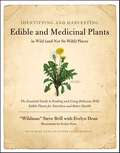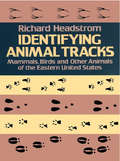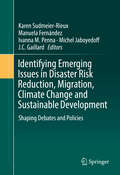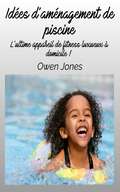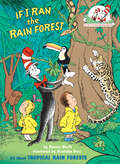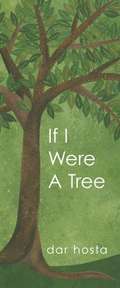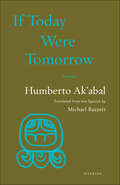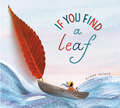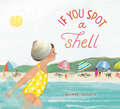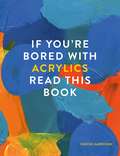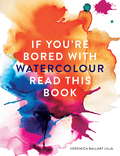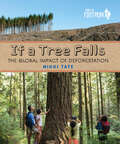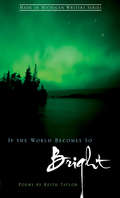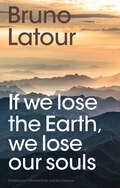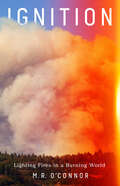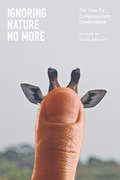- Table View
- List View
Identifying & Harvesting Edible and Medicinal Plants (And Not So Wild Places): The Essential Guide to Finding and Using Delicious Wild Edible Plants for Nutrition and Better Health
by Steve Brill Evelyn DeanIdentifying and Harvesting Edible and Medicinal Plants in Wild (and Not So Wild) Places shows readers how to find and prepare more than five hundred different plants for nutrition and better health. It includes information on common plants such as mullein (a tea made from the leaves and flowers suppresses a cough), stinging nettle (steam the leaves and you have a tasty dish rich in iron), cattail (cooked stalks taste similar to corn and are rich in protein), and wild apricots (an infusion made with the leaves is good for stomach aches and digestive disorders). More than 260 detailed line drawings help readers identify a wide range of plants -- many of which are suited for cooking by following the more than thirty recipes included in this book. There are literally hundreds of plants readily available underfoot waiting to be harvested and used either as food or as a potential therapeutic. This book is both a field guide to nature's bounty and a source of intriguing information about the plants that surround us.
Identifying Animal Tracks: Mammals, Birds, and Other Animals of the Eastern United States
by Richard HeadstromFor hunters, naturalists, scouts, nature lovers. How to recognize tracks of alligators, bobcats, centipedes, owls, skunks, toads, and many other animals. Diagrams of tracks, tips on identification. "...interesting and a good inexpensive introduction..." -- The Naturalist (UK).
Identifying Emerging Issues in Disaster Risk Reduction, Migration, Climate Change and Sustainable Development
by Karen Sudmeier-Rieux Manuela Fernández Ivanna M. Penna Michel Jaboyedoff J. C. GaillardThe proposed book is a timely contribution to researchers, students, scholars and policy makers in the fields of environment, human geography, development and disaster studies towards providing a more comprehensive grasp of contemporary development issues. Contributions include well-known practitioners and scientists that provide theoretical discussions as well as field observations regarding climate change adaptation, migration, disaster risk reduction and sustainable development linkages from around the world. One of the main barriers to furthering our understanding about the inter-linkages between these forces of development (or lack thereof) is the silo approach with which we address such issues. In spite of political talk about how to bridge gaps between climate change adaptation and disaster risk reduction, institutional architectures and frameworks maintain the divisions. The goal of this book is to explore these inter-linkages from a number of different geographical, social and natural science angles and contribute to the debate about how to improve disaster risk reduction (DRR) policies and practices, taking into account migration process from a large perspective where both natural and social factors are crucial and mutually "alloyed".
Identifying Trees of the West: An All-Season Guide to Western North America
by Lois DeMarco Jay MengelA field guide to every common tree in Western North America, with hundreds of color photos. Learn how to recognize trees you see every day by their bark; branching patterns; fruits, flowers, or nuts; and overall appearance. Created for in-the-field or at-home use, this guide is an easy-to-use resource that covers every common tree in western North America—from the eastern base of the Rocky Mountains to the Pacific coast. Clearly written for both beginning and advanced botanists, it provides tips for identification throughout a tree&’s lifespan and in every season of the year.
Iditarod Memories: 30 Years of Poster Art from the Last Great Race
by Jona Van ZyleA collection of annual posters from the official artist of the Iditarod Trail Sled Dog Race. Included are stories about how each of the first 30 posters came to be created, and the stories they tell about the race.
Idée d'aménagement de piscine: Comment amenager et sécuriser votre piscine
by Owen JonesDescription du livre: J'espère que vous trouverez les informations utiles, utiles et profitables. Les informations contenues dans ce livre électronique sur la façon de tirer le meilleur parti de toutes les idées que vous pouvez avoir au sujet d'une piscine domestique sont organisées en 17 chapitres d'environ 500 à 600 mots chacun. J'espère qu'elles intéresseront ceux qui souhaitent créer une piscine domestique ou en tirer le meilleur parti. Il sera également utile à ceux qui envisagent de se lancer dans la création ou l'entretien de piscines. Il s'agit toutefois d'un guide pour débutants, mais j'espère qu'il suffira à vous intéresser ou à vous lancer. En prime, je vous autorise à utiliser le contenu de ce guide sur votre propre site web ou dans vos blogs et bulletins d'information, mais il est préférable que vous le réécriviez d'abord avec vos propres mots. Vous pouvez également diviser le livre et revendre les articles. En fait, le seul droit que vous n'avez pas est de revendre ou de donner le livre tel qu'il vous a été livré.
If Bees Disappeared (If Animals Disappeared #1)
by Lily WilliamsWhat would happen if bees disappeared? Find out in this fourth book from Lily Williams in the award-winning If Animals Disappeared Series that imagines the consequences of a world without bees.The rolling hills and lush climate of Kent, England are home to many creatures.These creatures are fluffy, sneaky, spikey, and ... small, like the bee.Though bees are small, their importance is BIG. Today there are over 250,000 species of bees but all of them are in danger. Because of disease, pesticide exposure, lack of foraging habitats, and poor nutrition, entire honey bee hives are dying.What would happen if bees disappeared completely?Artist Lily Williams explores how such a loss would effect not just bees' environment, but the world as a whole in this poignant, beautiful book about the importance of our most important bees.
If Elephants Disappeared (If Animals Disappeared)
by Lily WilliamsWhat would happen if elephants disappeared? Trace the repercussions of a world without elephants in writer and illustrator Lily Williams' third picture book about loss and conservation.The Congolese forest is home to many types of animals. Some are strong. Some are slippery.Some are loud.And some, like the elephant, are BIG.The elephant has become synonymous with the image of African wildlife. They can grow over 10 feet tall and eat up to 300 pounds a day. While these giants are beloved figures in movies and zoos, they also play a large role in keeping the forest ecosystem healthy.Unfortunately, poachers are hunting elephants rapidly to extinction for their ivory tusks, and that could be catastrophic to the world as we know it.
If I Ran the Rain Forest: All About Tropical Rain Forests (Cat in the Hat's Learning Library)
by Bonnie WorthThe Cat in the Hat takes Sally and Dick for an “umbrella-vator” ride through the understory, canopy, and emergent layers of a tropical rain forest, encountering a host of plants, animals, and native peoples along the way.
If I Were A Tree (Into Reading, Read Aloud Module 10 #1)
by Dar HostaNIMAC-sourced textbook <P><P>Tree Huggers everywhere will rejoice in this colorful and poetic celebration of the woody-stemmed wonders with whom we share our Earth. In this fourth picture book from Dar Hosta, trees are brought to life with vibrant color and cut paper collages. Gentle verse describes a variety of tree species in all seasons. Hosta pays homage to their importance in our day to day lives and encourages thoughtful readers to imagine how it would be to BE a tree. Includes tree fact page and a diagram of a tree's basic parts.
If Polar Bears Disappeared (If Animals Disappeared)
by Lily WilliamsThe freezing ecosystem in the far north of the globe is home to many different kinds of animals. They can beStrong, like a walrusTough, like a lemmingResilient, like an arctic foxBut no arctic animal is as iconic as the polar bear.Unfortunately, the endangered polar bear is threatened with extinction due to rapid climate change that is causing the ice where it hunts/lives to melt at an alarming rate. If Polar Bears Disappeared uses accessible, charming art to explore what would happen if the sea ice melts, causing the extinction of polar bears, and how it would affect environments around the globe.
If Tigers Disappeared (If Animals Disappeared)
by Lily WilliamsWhat would happen if tigers disappeared? Find out in this fifth book in the award-winning If Animals Disappeared series that imagines the consequences of a world without tigers.Deep in the Biligirirangana Hills in India, a fierce creature roams. This landscape is home to animals that are slithery smart hidden and....LOUD like the roar of a tiger.There are nine subspecies of tigers, but three are now extinct. They play a very important role in keeping nature in balance. But, due to expanding human populations, poaching, and more, they’re in danger. What would happen if tigers disappeared completely? Join Lily Williams as she tracks the devastating reality of what our world might look like without tigers.
If Today Were Tomorrow: Poems
by Humberto Ak'abalA masterful collection of poems rooted in K’iche’ Maya culture illustrating all the ways meaning manifests within our world, and how best to behold it.“My language was born among trees, / it holds the taste of earth; / my ancestors’ tongue is my home.” So writes Humberto Ak’abal, a K’iche’ Maya poet born in Momostenango, in the western highlands of Guatemala. A legacy of land and language courses through the pages of this spirited collection, offering an expansive take on this internationally renowned poet’s work.Written originally in the Indigenous K’iche’ language and translated from the Spanish by acclaimed poet Michael Bazzett, these poems blossom from the landscape that raised Ak’abal—mountains covered in cloud forest, deep ravines, terraced fields of maize. His unpretentious verse models a contraconquista—counter-conquest—perspective, one that resists the impulse to impose meaning on the world and encourages us to receive it instead. “In church,” he writes, “the only prayer you hear / comes from the trees / they turned into pews.” Every living thing has its song, these poems suggest. We need only listen for it.Attuned, uncompromising, Ak’abal teaches readers to recognize grace in every earthly observation—in the wind, carrying a forgotten name. In the roots, whose floral messengers “tell us / what earth is like / on the inside.” Even in the birds, who “sing in mid-flight / and shit while flying.” At turns playful and pointed, this prescient entry in the Seedbank series is a transcendent celebration of both K’iche’ indigeneity and Ak’abal’s lifetime of work.
If You Find a Leaf
by Aimee SicuroAn exquisite picture book that celebrates the fall season and encourages children to see the colorful leaves around them in an entirely new way. The artist uses real leaves of vibrant hues to make her oh-so-charming illustrations.Every year, gusts of wind blow colorful autumn leaves to the ground. Some leaves make a crunch under foot, and others are so beautiful they deserve to be saved. In this story a young artist draws inspiration from the leaves she collects and every leaf sparks a new idea. She imagines turning a Japanese Zelkova leaf into a boat to sail far away, a Honey Locust leaf into a swing to sway in the gentle breeze, and an American Basswood leaf into a hot air balloon to float high above the trees. Any young reader who turns the pages of this beautiful book will be inspired to use their own imagination as they hunt for leaves this fall. And for young readers who want to make their own leaf creations there are tips for including leaves in their artwork and additional fun craft ideas.
If You Spot a Shell (If You Find a Treasure Series)
by Aimée SicuroA stunning companion to If You Find a Leaf, this cheery picture book captures the excitement of summer and encourages children to see their collected seashells in an entirely new way. The artist incorporates real shells into her exquisite illustrations.A warm summer breeze and the gentle waves of the ocean wash ashore many different types of shells. In this story a girl collects shells and thinks of all the magnificent things they can be turned into with a little creativity. She imagines one shell as a swimming cap for diving into the crashing waves, another as a magical kaleidoscope, one as a rocket ship to take her way up high and another as a submarine for exploring the wonders of the world below. The girl draws inspiration from the unique beauty of each and every shell.In this joyous celebration of a day at the beach, artist Aimee Sicuro uses real shells she&’s hand selected to make her oh-so-charming illustrations. Any young reader who turns the pages of this beautiful book will be inspired to use their own imagination as they comb the beach for shells this summer.
If You Want to Visit a Sea Garden
by Kay WeismanDiscover the wonder of ancient sea gardens on the Northwest Coast Sea gardens have been created by First Peoples on the Northwest coast for more than three thousand years. These gardens consist of stone reefs that are constructed at the lowest tide line, encouraging the growth of clams and other marine life on the gently sloped beach. This lyrical story follows a young child and an older family member who set out to visit a sea garden early one morning, as the lowest tides often occur at dawn. After anchoring their boat, they explore the beach, discover the many sea creatures that live there, hear the sputtering of clams and look closely at the reef. They reflect on the people who built the wall long ago, as well as those who have maintained it over the years. After digging for clams, they tidy up the beach, then return home.An author’s note provides further information about sea gardens (also known as clam gardens), which yield a reliable food source and have been traditional places of learning. They have been found along the Pacific coast, from Alaska to British Columbia to Washington State, and some of these gardens are being restored today.The manuscript has been vetted and approved by the scientists of the Clam Garden Network and Kwaxsistalla Wathl’thla Clan Chief Adam Dick. Roy Henry Vickers, whose ancestry includes the Tsimshian, Haida and Heiltsuk First Nations, has created hauntingly beautiful images to accompany the text.Key Text Featuresauthor’s noteCorrelates to the Common Core State Standards in English Language Arts:CCSS.ELA-LITERACY.RI.K.2>With prompting and support, identify the main topic and retell key details of a text.CCSS.ELA-LITERACY.RI.K.6Name the author and illustrator of a text and define the role of each in presenting the ideas or information in a text.
If You're Bored With Acrylics, Read This Book (If You're ... Read This Book Ser.)
by Denise HarrisonUnlock the potential in your paint tubes with 30 guided projects, covering everything from creating a harmonious colour palette to painting vivid landscapes and pop-art portraits. Get back to basics and explore the possibilities of colour, mark-making, textures, tools and techniques, or push the boundaries of acrylics by altering the qualities of the paint. This book will challenge your preconceptions about acrylics, and encourage you to return to the medium with fresh eyes and new ideas.
If You're Bored With Acrylics, Read This Book (If you're ... Read This Book #4)
by Denise HarrisonUnlock the potential in your paint tubes with 30 guided projects, covering everything from creating a harmonious colour palette to painting vivid landscapes and pop-art portraits. Get back to basics and explore the possibilities of colour, mark-making, textures, tools and techniques, or push the boundaries of acrylics by altering the qualities of the paint. This book will challenge your preconceptions about acrylics, and encourage you to return to the medium with fresh eyes and new ideas.
If You're Bored With WATERCOLOUR Read This Book (If you're ... Read This Book #1)
by Veronica Ballart LiljaAre you bored of painting tasteful landscapes, light seascapes and delicate still-lifes? Or are you labouring under the misconception that that is simply all watercolour is good for? Maybe you're so bored of looking at watercolour paintings that you've never even tried it! Whether you're at the beginning of your artistic journey, stuck in a rut and in desperate need of some inspiration or simply looking to improve your skills with watercolour, this book is sure to awaken your creativity. Stimulate your artistic minds and open your paint boxes to a whole new realm of possibility, using things like bleach, salt and combs - yes, the thing you'd ordinarily use to brush your hair with - to create exciting results.Professional fashion illustrator Veronica Ballart Lilja shares a wealth of new techniques based on her years of working with the medium that will open up watercolour for beginners, and encourage experts to stray from their more traditional methods. Jam packed with fresh ideas, adventurous tips and techniques, detailed theory and engaging exercises, this book allows you to develop and practise your skills in a free and expressive way.
If a Tree Falls: The Global Impact of Deforestation (Orca Footprints #18)
by Nikki TateEvery day more of the world’s forests disappear. Trees are cleared for agriculture, lost in wildfires and harvested for the valuable products they supply. Called the lungs of the planet, forests play a critical role in climate moderation. What happens when they’re gone? Are replanting and afforestation efforts helping? In If A Tree Falls: The Global Impact of Deforestation, author Nikki Tate gives an accessible and balanced look at forest practices throughout history, the growth of industry and the fight for preservation. Global deforestation affects us all. Find out what you can do to protect forests today and keep them healthy for future generations.
If the Shoe Fits
by Deborah GuarinoEver wonder what might have happened if a certain glass slipper had been placed on the wrong maiden's foot . . . and fit?! In this comic twist on a classic fairy tale, Murray, a humble shoemaker, presents a pair of glass slippers to the frantic fairy godmother when her wand runs out of power, setting off a rollicking chain of events that may force him to disappoint a prince, risk the fairy’s wrath, and sacrifice the secret love of his life. Deborah Guarino, author of the bestselling Is Your Mama a Llama?, has created a magical story that will delight readers of all ages. Vivid illustrations bring the characters brilliantly to life in this tale of true love, royal mayhem, and big feet.
If the World Becomes So Bright: If The World Becomes So Bright
by Keith TaylorA lyrical and accessible collection that explores both the landscape of Michigan and the inner life of one person who lives there.
If we lose the Earth, we lose our souls
by Bruno LatourIn this book Bruno Latour calls upon Christians to join the struggle to avert a climate catastrophe. First and foremost, Christians need to overcome their lack of interest in “earthly things” and pay attention to the Earth at a time when it is being neglected. He also urges Christians to renew their understanding of their faith in the context of the new image of the world that has emerged from earth system science – that of a world in which the myriad of beings that inhabit the world are interdependent and living in close proximity on a slender, fragile membrane on the surface of the planet. This new image of the world cannot fail to have an impact on the sciences, on politics, and on religion, just as, in earlier centuries, the cosmology of Copernicus and Galileo upset the old order. Latour sees the ecological crisis, and the cosmological mutation that it entails, as an opportunity to convey anew, to the largest possible audience, the tradition of Christianity as it has never been appreciated before, by bringing to bear the lessons of eschatology on the great crisis that looms before us all.
Ignition: Lighting Fires in a Burning World
by M.R. O'ConnorA work of on-the-ground reporting into the science of, and cultural ideas around, wildfires and fire management that challenges the ethos of the conservation movement, offering a hopeful vision of the connection between humans and our environment. In a riveting investigation of the science and ecology of wildfires, journalist M.R. O'Connor ventures into some of the oldest, most beautiful, and remote forests in North America to explore the powerful and ancient relationship between trees, fires, and humans. Along the way, she describes revelatory research in the fields of paleobotany and climate science to show how the world's forests have been shaped by fire for hundreds of millions of years. She also reports on the compelling archeological evidence emerging from the field of ethnoecology that proves how, until very recently, humans were instigators of forest fires, actively molding and influencing the ecosystems around them by inserting themselves into the loop of a natural biological process to start &“good fires.&” As she weaves together first-hand reportage with research and cultural insights, O'Connor also embeds on firelines alongside firefighters and &“pyrotechnicians.&” These highly trained individuals are resurrecting the practice of prescribed burning in an effort to sustain fire-dependent forest ecologies and prevent the catastrophic wildfires that are increasing in frequency and intensity as a result of global warming. Hailing from diverse backgrounds including state and federal agencies, scientific laboratories, and private lands and tribal nations, these fire starters are undertaking a radical and often controversial effort to promote, protect, and expand the responsible use of fire to restore ecological health to landscapes. At the heart of Ignition is a discussion about risk and how our relationship to it as a society will determine our potential to survive the onslaught of climate change.
Ignoring Nature No More: The Case for Compassionate Conservation
by Marc BekoffFor far too long humans have been ignoring nature. As the most dominant, overproducing, overconsuming, big-brained, big-footed, arrogant, and invasive species ever known, we are wrecking the planet at an unprecedented rate. And while science is important to our understanding of the impact we have on our environment, it alone does not hold the answers to the current crisis, nor does it get people to act. In Ignoring Nature No More, Marc Bekoff and a host of renowned contributors argue that we need a new mind-set about nature, one that centers on empathy, compassion, and being proactive. This collection of diverse essays is the first book devoted to compassionate conservation, a growing global movement that translates discussions and concerns about the well-being of individuals, species, populations, and ecosystems into action. Written by leading scholars in a host of disciplines, including biology, psychology, sociology, social work, economics, political science, and philosophy, as well as by locals doing fieldwork in their own countries, the essays combine the most creative aspects of the current science of animal conservation with analyses of important psychological and sociocultural issues that encourage or vex stewardship. The contributors tackle topics including the costs and benefits of conservation, behavioral biology, media coverage of animal welfare, conservation psychology, and scales of conservation from the local to the global. Taken together, the essays make a strong case for why we must replace our habits of domination and exploitation with compassionate conservation if we are to make the world a better place for nonhuman and human animals alike.
